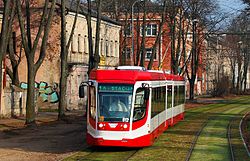Daugavpils
Daugavpils (Latvian pronunciation: [ˈdaʊɡaʊpils] (![]() listen); Latgalian: Daugpiļs [ˈdaʊkʲpʲilʲsʲ]; Russian: Даугавпилс [ˈdaʊɡəfpʲɪls]) is a city in southeastern Latvia. It is on the banks of the Daugava River, from which the city gets its name. Daugavpils literally means "Daugava Castle". It is the second largest city in the country after the capital Riga.
listen); Latgalian: Daugpiļs [ˈdaʊkʲpʲilʲsʲ]; Russian: Даугавпилс [ˈdaʊɡəfpʲɪls]) is a city in southeastern Latvia. It is on the banks of the Daugava River, from which the city gets its name. Daugavpils literally means "Daugava Castle". It is the second largest city in the country after the capital Riga.
City | |
 | |
 Location of Daugavpils within Latvia | |
| Coordinates: 55°52′30″N 26°32′8″E / 55.87500°N 26.53556°ECoordinates: 55°52′30″N 26°32′8″E / 55.87500°N 26.53556°E | |
| Country | |
| Established | 1275 |
| Town rights | 1582 |
| Government | |
| • Chairman of the City Council | Rihards Eigims |
| • Number of city council members | 15 |
| Area | |
| • Total | 72.48 km2 (27.98 sq mi) |
| • Water | 9.75 km2 (3.76 sq mi) |
| Highest elevation | 139 m (456 ft) |
| Lowest elevation | 86 m (282 ft) |
| Population (1 January 2017)[1] | |
| • Total | 94,196 |
| • Rank | 2 |
| • Density | 1,299.61/km2 (3,365.98/sq mi) |
| Time zone | UTC+2 (EET) |
| • Summer (DST) | UTC+3 (EEST) |
| Postal code | LV-54(01–65) |
| Website | www |
Daugavpils Media
A 1912 photo by Prokudin-Gorsky
Polish 5th Legions' Infantry Regiment in Daugavpils in 1920
Daugavpils Ghetto in July 1941
Ss Boris and Gleb Orthodox Cathedral at Church Hill. It is the biggest Orthodox church in Latvia
An Art Nouveau building on 41 Saules street
References
- ↑ "Latvijas iedzīvotāju skaits pašvaldībās 01.01.2012. (PDF)" (PDF) (in latviešu). PMLP.gov.lv. Archived from the original (PDF) on September 19, 2012. Retrieved April 29, 2012.











